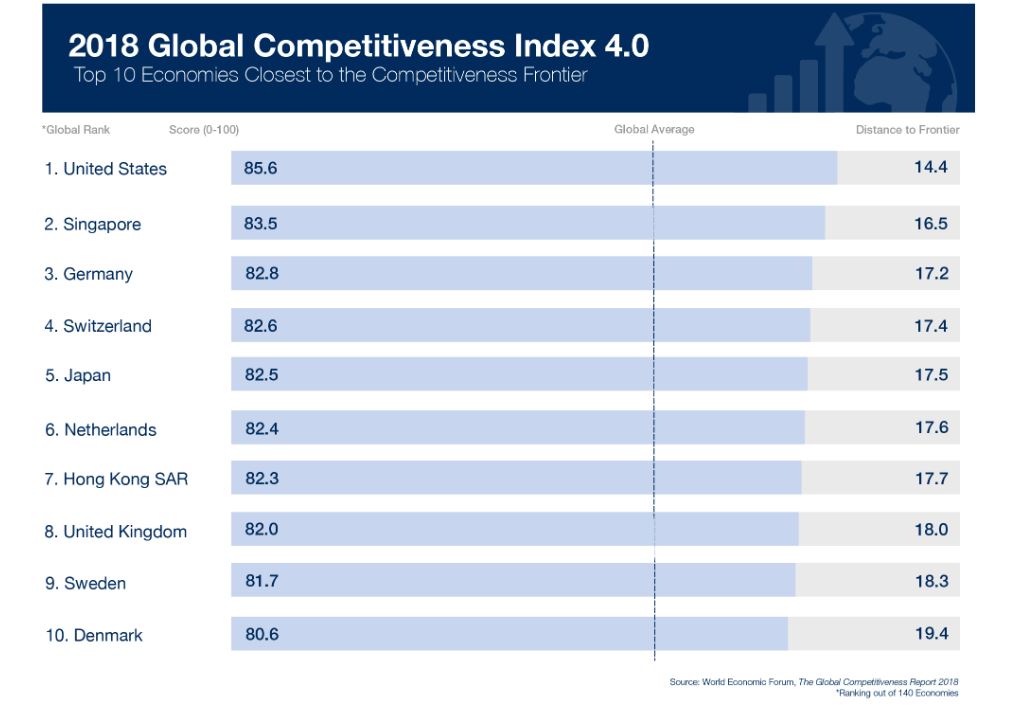
America first, Singapore second and Germany third
Productivity is considered the most important determinant of long-term economic growth and income. The Global Competitiveness Index 4.0 featured in the World Economic Forum’s Global Competitiveness Report 2018 emphasizes a newly emerging set of factors critical for productivity in the 4th Industrial Revolution. Efficiency and cost-cutting remain important for economic success. However, innovation, flexibility and adaptation to change are becoming key ingredients.
Authors:
- Brigitte Baldi, Senior Manager, Dennemeyer Consulting GmbH
- Dr. Cornelia Peuser, Consultant, Dennemeyer Consulting GmbH
The top ten economies in the index are led by the United States with a competitiveness score of 85.6 points, which is 14 points from the highest possible mark of 100 points. Second is Singapore (83.5), followed by Germany (82.8). In fourth place is Switzerland (82.6). Japan (82.5) moved up three positions to rank five since 2017. In the opposite direction, the Netherlands (82.4) went down to rank six (fifth in 2017), followed by Hong Kong SAR (82.3). The United Kingdom (82.0) lost two places and now ranks eighth. Sweden (81.7) is followed by the single new country in the top ten, Denmark (80.6). Canada dropped out of the top ten.
 Top 10 economies closest to the competitiveness frontier, ranking out of 140 economies. Source: World Economic Forum, The Global Competitiveness Report 2018.
Top 10 economies closest to the competitiveness frontier, ranking out of 140 economies. Source: World Economic Forum, The Global Competitiveness Report 2018.
As an example of an economy being known for its innovativeness, let’s have a look at Germany’s performance in this year’s competitiveness ranking. Germany emerges as the strongest European performer in the report. In particular, it stands out for its innovation ecosystem and ranks first in the innovation capability pillar (one of twelve pillars that comprise the overall index) with a score of 87.5 of 100 and only second behind the United States in the business dynamism pillar with a score of 81.6 of 100.
Germany: Highly innovative, but inflexible
The innovation capability pillar covers indicators that reflect the path from first idea generation aspects subsumed under "interaction and diversity," invention development captured as "research and development" to "commercialization" by means of bringing innovative products and services to the market. Germany’s first rank on the innovation capability pillar is driven by a top performance in "patent applications" (rank 5), in "scientific publications" (rank 3), "quality of research institutions" (rank 4), and by a high degree of "buyer sophistication" (rank 5), which means customers continuously challenge businesses to innovate. On the other hand, Germany’s "R&D expenditures" measured in percent of GDP ranks only 10th.
Globally speaking, the innovation capability pillar has the lowest performance compared to the other eleven pillars considered in the report. The distribution of scores is so skewed that the report’s authors consider the three best performing economies Germany (87.5), United States (86.5) and Switzerland (82.1) statistical outliers.
In the innovation ecosystem, there is a second pillar named business dynamism where Germany (81.6) is second behind the United States (86.5). This pillar reflects first on "entrepreneurial culture," for example the willingness to take risks and to try new business ideas. Secondly, the "administrative requirements" such as "cost" and "time to start a business" or "insolvency regulations" are considered. The score value difference of five points already reveals a larger gap to the leading economy. For example, rank 66 for Germany in "time to start a business" or rank 41 in "cost of starting a business" indicate that the legal and administrative environment in Germany is still not overly conducive to entrepreneurship despite efforts at improvement over the past few years.
“In WEF’s current Global Competitiveness Report, Germany gives a mixed impression. On the one hand, the country is leading in fields such as scientific publications, research institutions and patent applications,” says Dr. Nowak, CEO of the Dennemeyer Group. “It seems that the private sector has the entrepreneurial culture necessary to turn these intangible assets into measurable monetary results. On the other hand, the country still has room for improvement when it comes to the political and legal framework. The government should support the economy better, for example by lowering administrative requirements, reducing costs for starting a new business and improving conditions for start-ups.”
Germany does not appear in the top ten of "future orientation of government." For instance, rank 21 in "intellectual property protection" and rank 26 in "strength of auditing and reporting standards" call for government action to foster a more favorable business environment. Meanwhile, every innovative company can and should take it into their own hands to improve their chances for success through comprehensive innovation and IP Management.
In the area of Intellectual Property, Dennemeyer can support businesses, for example by assessing their Innovation and Intellectual Property Performance.
Filed in

Explore the latest IP dramas, from an Olympic trademark dispute to challenges in drug patenting and a lawsuit for allowing music piracy.



